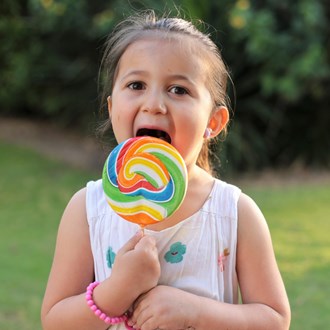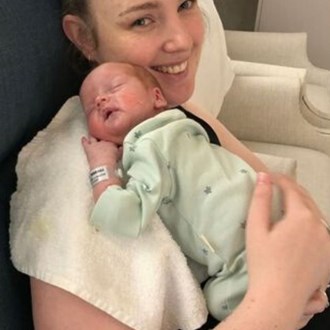Red, raw and sore! What to do when your baby has nappy rash...

It can be heartbreaking to see that cute little bottom all red and inflamed. Here's how to deal with nappy rash
By Linda Barnier
May 07 2019
What should I do if my baby has nappy rash?
Nappy rash is common in babies, and you’ll know if your child gets it.
The area where she wears her nappy will look red and raw and sometimes be bumpy and shiny. It can hurt, especially when she wees, so she may be unsettled while she has it. But there ways you can help her quickly and effectively.
What causes it?
The quickest way for nappy rash to appear is to leave your little one in a wet nappy for too long. Even the most absorbent nappies leave some moisture on the skin and if her skin is too wet for too long, its natural barrier will begin to break down. If the natural barrier becomes weak, bub’s skin becomes vulnerable to irritants in her wee and can become red and sore.
Other irritants like runny poos, plastic pants or materials that are too rough on the skin can also cause nappy rash, says Anne Partridge, director of nursing and clinical services at Tresillian. “Products with perfumes or strong ingredients can irritate the skin, too,” she adds.
Nappy rash can sometimes be mistaken for a yeast infection. A yeast infection usually looks angrier and more inflamed than nappy rash, but can also occur in conjunction with it.
Can I prevent nappy rash?
The easiest thing to do to reduce the risk of nappy rash is to change your baby’s nappy frequently. Wee and poo contain substances that can irritate or infect her skin, so clean the area thoroughly when you do.
Many parents wash the nappy area with just warm water for the first couple of weeks with a newborn. Adding a little mild liquid baby cleanser to the water is another option, or you could use specially formulated, sensitive, fragrance-free baby wipes. Using these won’t damage your baby's natural skin barrier.
Many parents like to use disposable wipes, but they’re not necessary, Anne says. “When you’re out of the house they can be useful, but at home, water and a soft cloth is fine,” she says. If you’re using disposable baby wipes, avoid ones with alcohol and fragrance, as these ingredients can irritate and dry out the skin.
You may also find you need to change nappy brands, as the brand you are currently using may not be absorbent enough or the materials the nappies are made from may be irritating her skin. BabyLove Nappy Pants have a 360° stretchy waistband so they pull up (and stay up) easily with no chafing tabs, are super soft and comfy thanks to the fit, and have 12-hour absorbency.
Watch what your child eats when she starts on solid foods, too. Because nappy rash can be triggered by frequent, runny poos, it’s a good idea to avoid things that can cause diarrhoea, such as grapes, prunes and fruit juices. Acidic foods such as citrus fruits should also be avoided when she has the rash because when she wees it may sting more.
Is nappy rash worse in cloth nappies?
Not necessarily, but this can be the case. One tip is to make sure you rinse cloth nappies really well AFTER they have been washed. This gets rid of any soap residue in your baby’s nappy that could cause some irritation.
Some parents use bleach to clean the clothe nappy - this gets rid of the bacteria but can be very irritating on skin. Make sure to rinse the nappies well in fresh water after using any bleach-based detergents and make sure the nappies are perfectly dry before using them again.
You should also avoid using plastic pants over the top of the cloth nappy because these can stop the skin breathing and allow bacteria to build up in warm, wet conditions.
If your baby has a bad case of nappy rash and you normally use cloth nappies, you could consider using disposable nappies until the rash has cleared up.

Getty
How do I treat nappy rash?
If your baby’s bottom becomes red and inflamed, your priority will be keeping the nappy area as dry as possible. You will also need a thick barrier cream to soothe and protect the skin from moisture. "Zinc-based creams are good,” Anne says.
Clean your little one’s nappy area thoroughly with lukewarm water and gently pat dry. Reapply a thick layer of barrier cream at each change and make sure all the affected areas are really well covered.
And remember to give that cute little bottom some air! It’s being in a nappy that causes the problem in the first place, so schedule some regular nappy-free time. She will love it! But make sure it’s not in the direct sunlight, as her delicate skin will burn easily.
What if the nappy rash doesn't clear up?
If treated properly, nappy rash should clear up in a few days. If it doesn’t, or is spreading or getting worse, consult your medical advisor. The rash can sometimes get infected and if it does, you'll need to see a professional health care provider.
TOP TIPS FOR NAPPY RASH
• Let baby have nappy-free time – nudie time is good for their skin!
• If nappy rash starts appearing, stop using plastic covers as they keep the wee/poo close to skin
• Pat dry rather than rub dry, so you don’t irritate the skin
• Wash with warm water, not with soap
• Use a nappy rash or barrier cream as this will protect baby’s skin from getting (more) irritated













